.jpg.webp)
The K-class ferries were a group of double-ended screw steam ferries run by Sydney Ferries Limited and its government successors on Sydney Harbour. The company introduced more than two dozen of the vessels from the 1890s through to the early twentieth century to meet the booming demand for ferry services across Sydney Harbour prior to the opening of the Sydney Harbour Bridge in 1932.
The K-names were largely Australian Aboriginal names with their meanings listed in the table below.
Design
The K-class were not a group of identical ferries - they were delivered in batches of two or three identical sister ships - rather they were a general type of vessel that ranged in sized but shared a typical form. They were all double-deck, double-ended screw steamers with two raised wheelhouses and a single tall funnel. Apart from a few early vessels with open upper decks that were later enclosed, the K-class had enclosed upper and lower saloons with lower deck outdoor seating around the vessel, and the upper decks had smaller outdoor areas at either end around the wheelhouses. The boats were all timber-hulled with timber superstructures, except for four later and larger vessels that had steel hulls and timber superstructures - namely, sisters Kanangra and Kirawa (both 1912) and sisters Kuttabul and Koompartoo (both 1922). The boats' upper deck sheer or profile line were curved parallel to the hull sheer, in contrast to many contemporary ferries whose upper deck was built straight fore and aft.
Kareela was the first of Sydney Ferries Limited to have upper decks fully enclosed. The earlier K-class vessels, including Kurraba, Kirribilli, Koree and Kulgoa had only the sides of their upper decks enclosed leaving the ends open, with the roofs being squared off. On Kareela and all subsequent K-class vessels had an upper deck structure with curving roof lines that met at the rear of the wheelhouses thus the upper deck saloon was fully enclosed. Sliding doors gave access to the a small unroofed area surrounding the raised wheelhouses.[1]
Service history
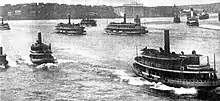
The ferry trade to the North Shore increased rapidly and consistently from the turn of the century until the opening of the Sydney Harbour Bridge in 1932. The Sydney Ferries fleet became one of the largest in the world - the bulk of which in number and capacity were K-class - and carried 40 million passengers per year by the 1930s. With the opening of the bridge, many of the K-class vessels were deemed redundant and were decommissioned. More still were decommissioned following the NSW State Government takeover of Sydney Ferries in 1951. A handful of the K-class ferries (Karingal, Karrabee, Kanangra, Kameruka) were in service until the mid-1980s having been converted to diesel in the 1930s and 1950s.
During the launch speech for Kaikai in 1906, Sydney Ferries acknowledged they were deliberately naming their vessels with Aboriginal words starting with the letter "K".[2]
List of K-class vessels
| Name | Year Built | Description | Origin of name | Tons | Length & beam (m) | Passengers | Out of service |
|---|---|---|---|---|---|---|---|
| Kangaroo (II) | 1891 | 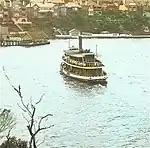 Kangaroo in Neutral Bay | Australian native animal | 158 tons | 34.1 by 6.6 metres (111 ft 11 in × 21 ft 8 in) | 632 | 1926 |
| Waringa Karaga | 1894 |  as Waringa (circa 1905-1907) | 125 tons | 32.2 by 6.3 metres (105 ft 8 in × 20 ft 8 in) | 588 | 1932(?), 1943 to RAN | |
| Wallaroo Kiamala | 1896 |  Wallaroo as built | Wallaroo, Australian native animal. | 122 tons | 32.4 m (106 ft) | 545 | 1943 to RAN |
| Carabella Karabella | 1897 | Sister to Wallaroo/Kiamala.[6] Built by Young, Son & Fletcher, Rozelle for North Shore Steam Ferry Company (later Sydney Ferries Limited) 30 hp compound steam engine by Muir & Houston Ltd. Received electric lighting 1901. Rebuilt, extended, and renamed Karabella in 1916. On 9 May 1901, collided with Rosedale near Milsons Point and damaged amidships. On 17 January 1902, collided with Sonoma and sponson damaged. Taken out of service following opening of Sydney Harbour Bridge in 1932, however, in 1936 returned to service as an excursion vessel mainly following the 18 footer races. Returned to passenger service in 1939 on Neutral Bay route. Taken over by Australian government in 1943 to assist the war effort.[7][6] | After a house built on North Shore in 1882-'Carrably' | 129 t, 1916: 151 tons | 32.0 by 6.6 metres (105 ft 0 in × 21 ft 8 in) | 595 | 1932(?) |
| Kurraba | 1899 |  Kurraba in Mosman Bay, c. 1909 | Sydney harbourside suburb | 195 tons | 40.9 metres (134 ft 2 in) | 890 | 1934 |
| Kirribilli (II) | 1900 | 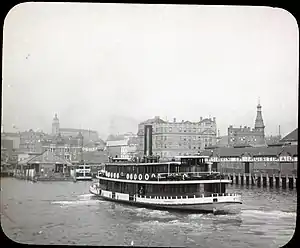 | Australian Aboriginal name meaning 'good fishing spot', and name of a Sydney suburb | 198 tons | 39.7 m x 7.9m | 896 | 1934 |
| Koree | 1902 | .jpg.webp) Koree carrying regatta spectators | An Australian Aboriginal name for Chowder Bay | 276 tons | 42.8 m x 8.6 m | 1,058 | 1934 |
| Kummulla | 1903 |  in Mosman Bay | An Australian Aboriginal name for "catch me". | 168 tons | 36.3 m x 7.6 m | 795 | 1934 |
| Kulgoa | 1905 | .jpg.webp) Kulgoa (1905) carrying regatta spectator crowds | Australian Aboriginal word meaning 'returning' | 338 tons | 42.7 m x 9.6 m | 1,255 | 1952 |
| Kareela | 1905 |  on Sydney Harbour ca. 1930 | Australian Aboriginal word for 'south wind' | 186 tons | 34.4 m x 8.2 m | 784 | 1959 |
| Kaikai | 1906 |  | Australian Aboriginal word for 'jewfish' or 'food' | 303 tons | 46.3 x 10.1 m | 1,245 | 1942 |
| Kookooburra | 1907 |  1930s or 1940s | Australian native bird | 180 tons | 42.7 m x 7.7 m | 700 | 1948-49(?) |
| Kaludah, formerly Kuranda | 1909 |  Kaludah 4 March 1911 Of similar design to Kookooburra with short funnel to pass under low bridges on Parramatta River service.[14] Kookooburra and Kaludah were the only K-class ferries to have pointed ends. Built of hardwood and kauri with bent frames. She had five bulk heads, four of which were iron.[16] Chapman and Co installed the machinery which was imported from Campbell & Calderwood in Scotland. The triple expansion steam engines (50 hp, 12 knots) had cylinders of diameter 12-inch, 20-inch, and 32.5 inch, with stroke length of 18-inches. She had two boilers each 18 feet long and 6 feet 9 inches in diameter with a working pressure of 180 lb.[16] Use of the name Kuranda appears to have been short lived - a July 1909 Sydney Morning Herald article notes "The Kaludah, formerly Kuranda, commenced running in the Parramatta River service in May."[17] Caught fire at her moorings on 22 March 1911, drifted downstream, brought under tow alight by fire boat Pelvius, burnt herself to the water line and sank in Tarban Creek[18]...the shortest lived of the Sydney ferries. Engines and usable timber went to the Kamiri,[19][20][21] | 137 tons | 35.1 x 7.6 m | 1911 | ||
| Kanimbla later Kurra-Ba | 1910 |  | Australian Aboriginal word for 'Big fight' | 156 tons | 35.4 m x 8.8 m | 791 | 1946(?) |
| Kirrule | 1910 | .jpg.webp) | Australian Aboriginal word for 'aroused' | 258 tons | 42.7 m x 9.2 m | 1,080 | 1951 |
| Kiandra | 1911 |  | a corruption of Aboriginal 'Gianderra' for 'sharp stones for knives' and town in NSW | 258 tons | 42.7 m x 9.2 m | 1,101 | 1951 |
| Kosciusko | 1911 |  as a steamer, pre-1932 | Australian mountain named after Polish military leader Tadeusz Kościuszko | 165 tons | 35.4 m x 8.7 m | 785 | 1975 |
| Kanangra | 1912 | 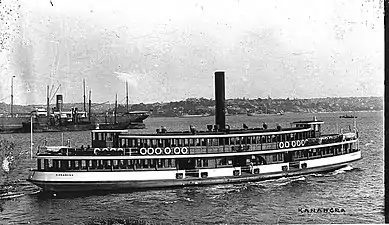 | Australian Aboriginal word for 'beautiful view' | 295 tons | 45.5 m x 9.7 m | 945 | 1985 |
| Kirawa | 1912 |  | Australian Aboriginal word for 'looking for them' | 295 tons | 45.5 m x 9.7 m | 1,070 | 1953 |
| Kubu | 1912 |  | Australian Aboriginal word for 'oak tree' | 258 tons | 42.7 m x 9.2 m | 1,072 | 1959 |
| Kamiri | 1912 | 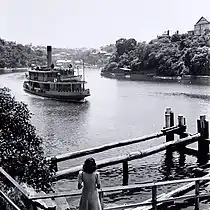 in Mosman Bay 1946 | Name of Aboriginal Australian tribe | 144 tons | 34.1 m x 7.9 m | 594 | 1951 |
| Kameruka | 1913 |  as a steamer, likely 1930s or 40s | Australian Aboriginal word meaning 'wait til I come' | 144 tons | 34.1 m x 7.9 m | 594 | 1984 |
| Karrabee | 1913 | 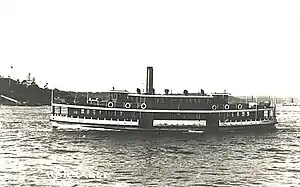 as built as a steamer | Australian Aboriginal word for 'Cockatoo' | 107 tons | 32.8 m | 653 | 1984 |
| Karingal | 1913 |  as a steamer | Australian Aboriginal word meaning 'happy home' | 107 tons | 31.7 m | 608 | 1984(?) |
| Kuramia | 1914 | Along with Kulgoa, at 335 tons, the largest wooden ferries on Sydney Harbour.[11] Built by David Drake Ltd, Balmain. 69 hp triple expansion steam engines by Mort's Dock & Engineering Co. Ltd. 12 knots. Engine sold 1940, requisitioned for naval use in 1942 as a boom gate vessel on the harbour boom off Watsons Bay.[7][33] Hulk sunk as target of Sydney, 10 October 1953. | 335 tons | 47.7 m | 1,357 | ||
| Kuttabul | 1922 | 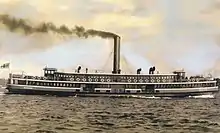 | Australian Aboriginal word for 'wonderful' | 447 tons | 55.7 m x 11.0 m | 2,089 | 1932 |
| Koompartoo | 1922 | Built by NSW Government Dockyard, Newcastle. 113 hp triple expansion steam engine by builder. 12 knots. Along with sister Kuttabul, was one of the two biggest ferries owned by Sydney Ferries and the largest ferry on Sydney Harbour by passenger capacity. Both vessels built for the short heavy lift run from Circular Quay to Milsons Point. Made redundant on the Milsons Point run following 1932 opening of the Sydney Harbour Bridge and converted to concert boat in 1935. Converted to Naval boom-gate vessel 1942-42. Sold to Commonwealth Government 1945. Stripped hull went to Tasmania 1966 to be used as a bauxite barge.[34] | Australian Aboriginal word meaning 'a fresh start' | 447 tons | 55.7 m x 11.0 | 2,089 | 1932(?) |
Notes
- ↑ Clark, L (1976). North of the Harbour. Broadmeadow, NSW: Newey & Beath Printers Pty Ltd. p. 10. ISBN 0-909650-05-5.
- ↑ ferriesofsydney.com
- ↑ "THE FERRY STEAMER KANGAROO". Evening News. No. 10, 580. New South Wales, Australia. 8 May 1901. p. 3. Retrieved 26 June 2021 – via National Library of Australia.
- 1 2 Andrews (1975), p. 30
- ↑ "NEW FERRY STEAMERS". The Sydney Morning Herald. No. 23, 643. New South Wales, Australia. 20 October 1913. p. 10. Retrieved 8 November 2021 – via National Library of Australia.
- 1 2 3 Prescott (1984), p 85
- 1 2 3 4 Andrews, Graeme (1975). The Ferries of Sydney. A.H. & A.W. Reed Pty Ltd. p. 93. ISBN 0589071726.
- ↑ Museum of Applied Arts and Sciences
- ↑ "THE KURRABA". The Australian Star. No. 4905. New South Wales, Australia. 3 November 1903. p. 3. Retrieved 12 December 2020 – via National Library of Australia.
- ↑ Andrews (1982), p. 40
- 1 2 Andrews (1975), pp. 93, 116, 117
- ↑ ferriesofsydney.com
- ↑ "SYDNEY FERRIES". The Sun. No. 2853. New South Wales, Australia. 25 August 1919. p. 5. Retrieved 16 October 2021 – via National Library of Australia..
- 1 2 Prescott (1984), pp. 15-16
- ↑ Gunter (1978), p. 77
- 1 2 3 4 "NEW STEAMER FOR THE SYDNEY FERRIES". The Daily Telegraph. No. 9214. New South Wales, Australia. 10 December 1908. p. 8. Retrieved 29 August 2021 – via National Library of Australia.
- ↑ "THE FERRY SERVICES". The Sydney Morning Herald. No. 22, 321. New South Wales, Australia. 30 July 1909. p. 10. Retrieved 29 August 2021 – via National Library of Australia.
- ↑ "FIRE ON A FERRY ROAT". The Brisbane Courier. Queensland, Australia. 23 March 1911. p. 5. Retrieved 4 January 2020 – via Trove.
- ↑ Gunter (1978), p. 11
- ↑ Gunter (1978), p. 73
- 1 2 Andrews (1975), p. 59
- 1 2 Andrews (1982), p. 96
- ↑ Andrews (1982), p. 104
- ↑ Ferries of Sydney - Kiandra
- ↑ "FERRIES COLLIDE IN SYDNEY HARBOUR". The Argus (Melbourne). Victoria, Australia. 12 August 1937. p. 9. Retrieved 4 January 2020 – via Trove.
- ↑ Andrews (1982), p. 97
- ↑ Prescott (1984), p. 71
- ↑ Andrews (1982), p. 98
- 1 2 Prescott (1984), p. 37
- ↑ Gunter (1978), p. 14
- ↑ Museum of Applied Arts and Sciences
- ↑ Andrews (1975), p. 19
- ↑ Gunter (1978), p 78
- ↑ Andrews (1975), p. 89
References
- Andrews, Graeme (1975). The Ferries of Sydney. A.H. & A.W. Reed Pty Ltd. ISBN 0589071726.
- Andrews, Graeme (1982). A Pictorial History of Ferries: Sydney and Surrounding Waterways. Sydney: AH & AW Reed Pty Ltd. ISBN 0589503863.
- Gunter, John (1978). Across the harbour : the story of Sydney's ferries. Rigby. ISBN 0727007157.
- Prescott, AM (1984). Sydney Ferry Fleet. Magill South Australia: Ronald H Parsons. ISBN 0909418306.
- ferriesofsydney.com
See also
External links
![]() Media related to Sydney K-class ferries at Wikimedia Commons
Media related to Sydney K-class ferries at Wikimedia Commons